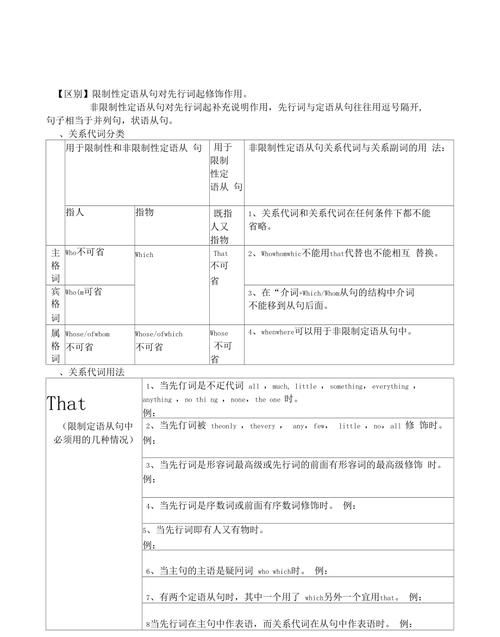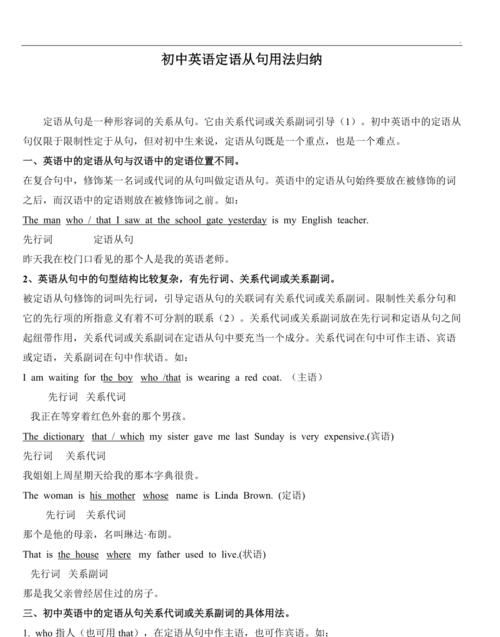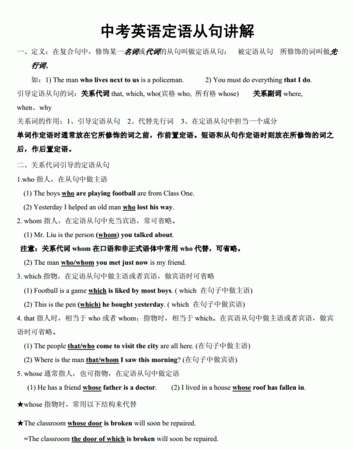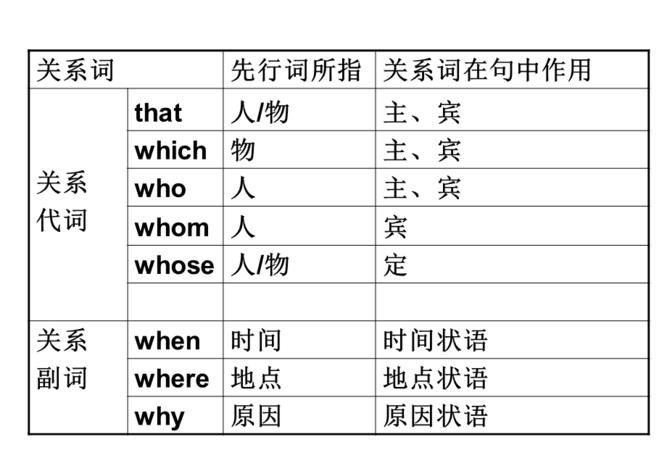本文目录
初中英语定语从句知识点总结
相信大家学习英语时都很痛苦,又要背单词,又要记语法,还要记时态等。下面我就整理了定语从句易错知识点,供大家参考。
定语从句易错易混点归纳
1.关系代词和关系副词的混用
例:I’ll never forget the days when I spent in New York with you.析:when应改为which或that。
2.固定句式出差错。
例:Mary is so lovely a girl as everybody loves her.析:as应改为that。
3.主谓不一致。
例:Tom is one of the students who likes swimming.析:likes应改为like。
4.与强调句型及其他句型的混合
例:Was it in the shop that you bought the recorder that you lost your pen?析:第一个that应改为where。
5.特殊名词作先行词时关系词的选取错误。
例:I don’t like the way which you speak to her.析:应在which前加in或将which改为that或去掉。
定语从句的概念
在复合句中,修饰某一名词或代词的从句叫定语从句。被修饰的名词或代词叫先行词,定语从句一般放在先行词的后面。
定语从句是由关系代词和关系副词引导的从句,其作用是作定语修饰主句的某个成分,定语从句分为限定性和非限定性从句两种。状语从句分为时间状语从句,结果状语从句,让步状语从句,原因状语从句,条件状语从句以及行为方式状语从句。名词从句包括主语从句,宾语从句,表语从句和同位语从句及there be句型。
定语从句的关系词
引导定语从句的关系词有关系代词和关系副词,常见的关系代词包括that,which,who(宾格whom,所有格whose)等,关系副词包括where,when,why等。关系代词和关系副词放在先行词及定语从句之间起连接作用,同时又作定语从句的重要成分。

定语从句初中知识点
一、定语从句的概念
在复合句中,修饰某一名词或代词的从句叫定语从句。被修饰的名词或代词叫先行词,引导定语从句的词叫关系词,定语从句一般放在先行词的后面。
二、定语从句的关系词
引导定语从句的关系词有关系代词和关系副词,常见的关系代词包括that, which, who(宾格whom,所有格whose)等,关系副词包括where, when, why等。关系代词和关系副词放在先行词及定语从句之间起连接作用,同时又作定语从句的重要成分。
三、定语从句的分类
根据定语从句与先行词的关系,定语从句可分为限制性定语从句及非限制性定语从句。限制性定语从句紧跟先行词,主句与从句不用逗号分开,从句不可省去。非限制性定语从句与主句之间有逗号分开,起补充说明作用,如省去,意思仍完整。
四、关系代词的用法
1. that 既可以用于指人,也可以用于指物。在从句中作主语、宾语或表语。作主语时不可省略,作宾语可省略。例如:
Mary likes music that is quiet and gentle.
玛丽喜欢轻柔的音乐。(that作主语)
The coat (that) I put on the desk is blue.
我放在桌子上的那件外套是蓝色的。(that作宾语)
2.which用于指物,在句中作主语、宾语或表语。作主语不可省略,作宾语可省略。例如:
The building which stands near the train station is a supermarket.
位于火车站附近的那座大楼是一家超市。(作主语)
The film (which) we saw last night was wonderful.
我们昨天晚上看的那部电影很好看。(作宾语)
3.who, whom用于指人,who 用作主语,whom用作宾语。在口语中,有时可用who代替whom。who和whom作宾语时也可省略。例如:
The girl who often helps me with my English is from England.
经常在英语方面帮助我的那个女孩是英国人。(作主语)
Who is the teacher (whom) Li Ming is talking to?
正在与李明谈话的老师是谁?(作宾语)
注意:(1)当定语从句中含有介词,介词放在句末时,who,whom,that, which可省略,但介词在关系代词前时,只能用“介词+which/whom”结构。例如:
This is the house in which we lived last year.
这是我们去年居住的房子。
Please tell me from whom you borrowed the English novel.请告诉我你从谁那借的这本英文小说。
(2)含有介词的固定动词词组中,介词不可前置,只能放在原来的位置上。例如:
This is the person whom you are looking for.
这就是你要找的那个人。
(3)that 作介词的宾语时,介词不能放它的前面,只能放在从句中动词的后面。例如:
The city that she lives in is very far away.
她居住的城市非常远。
(4)关系词只能用that的情况:
a. 先行词被序数词或形容词最高级所修饰,或本身是序数词、基数词、形容词最高级时,只能用that,而不用which.例如:
He was the first person that passed the exam.
他是第一个通过考试的人。
b. 被修饰的先行词为all, any, much, many, everything, anything, none, the one等不定代词指物时,只能用that,而不用which.例如:
Is there anything that you want to buy in the shop?
你在商店里有什么东西要买吗?
c.先行词被the only, the very, the same, the last, little, few 等词修饰时,只能用that,而不用which.例如:
This is the same bike that I lost.
这就是我丢的那辆自行车。
d.先行词里同时含有人或物时,只能用that, 而不用which.例如:
I can remember well the persons and some pictures that I saw in the room.
我能清楚记得我在那个房间所见到的人和一些照片。
e.以who或which引导的特殊疑问句,为避免重复,只能用that.例如:
Who is the girl that is crying?
正在哭泣的那个女孩是谁?
f.主句是there be 结构,修饰主语的定语从句用that,而不用which.例如:
There is a book on the desk that belongs to Tom.
桌子上那本书是汤姆的.。
(5)关系词只能用which,而不用that 的情况:
a.先行词为that, those时,用which, 而不用that.例如:
What’s that which is under the desk?
在桌子底下的那些东西是什么?
b.关系代词前有介词时,which,而不用that.例如:
This is the room in which he lives.
这是他居住的房间。
c.引导非限制性定语从句,用which, 而不用that.例如:
Tom came back, which made us happy.
汤姆回来了,这使我们很高兴。
五、关系副词的用法
(1)when指时间,其先行词表示时间,when在定语从句中作时间状语。例如:
This was the time when he arrived.
这是他到达的时间。
(2)where指地点,其先行词表示地点,where在定语从句中作地点状语。例如:
This is place where he works.
这是他工作的地点。
(3)why 指原因,其先行词是原因,why在定语从句中做原因状语。例如:
Nobody knows the reason why he is often late for school.
没人知道他为什么上学总迟到。
历年定语从句真题及解析
1. A friend is someone______ says, "What! You too? I thought I was the only one!”
A. who
B. Which
C. What
D. whose
【答案】A
【解析】考查定语从句的用法。先行词是someone,表人,排除B,what不能引导定语从句,排除C;先行词和空格后的单词无所属关系,排除D。故选A。
2. 一Linda, can you tell me something about Mo Yan?
—Sure. He is the writer ______won the Nobel(诺贝尔) Literature Prize.
A. which
B. whose
C. who
D. whom
【答案】C
【解析】考查定语从句的引导词的用法。which先行词为物时;whose先行词为人或物,作定语,后得接名词;who先行词为人,作主、宾、表语;whom先行词为人,只作宾语。根据先行词the writer作者,作主语。所以选择答案C。
3. A Wechat (微信) is an invention ______ can help people talk to friends, share photos, ideas and feeling freely.
A. which
B. who
C. whose
D /
【答案】A
【解析】考查定语从句。which can help people talk to friends, share photos, ideas and feeling freely是定语从句,修饰先行词invention,而先行词是物,关系代词用which或that。故选A。
4. I still remember the college and the teachers________I visited in London years ago.
A. what
B. who
C. that
D. which
【答案】C
【解析】考查定语从句的连接词的用法。who“谁”,what“什么”,that“那个”,which“那个”。这里是引导定语从句,用来修饰the college and the teachers,既包括人又包括物,所以关系词只能用用that,而不能用which,所以选择答案C。
5. Yesterday Li Ming went to the village_________ his family lived ten years ago.
A. when
B. which
C. where
D. that
【答案】C
【解析】考查定语从句引导词。定语从句的先行词the village, 在定语从句中充当的是地点状语,所以用关系副词where引导, 故选C。
6. I like the cartoon __ has a happy ending and makes me .
A. which; to laugh
B. that; to laugh
C. whose; laughing
D. which; laugh
【答案】D
【解析】考查定语从句的引导词及非谓语动词。句意:我喜欢完满结局、让我笑的动画片。先行词the cartoon是物,故定语从句的用关系代词用that/which;再由make sb. do sth.为固定结构,答案为D。
7. —What kind of music do you like?
—I like music ______ I can dance to.
A. because
B. when
C. who
D. that
【答案】D
【解析】考查定语从句的用法。句意:——你喜欢哪种音乐?——我喜欢能随之跳舞的音乐。关系代词that在定语从句中作介词to的宾语,故选D。
8. —Look! That is the womanI met yesterday.
—Oh? She’s my aunt.
A. what
B. who
C. where
D. when
【答案】B
【解析】考查定语从句。先行词是the woman,且在定语从句中作met的宾语可知用关系代词who。所以选择答案B。
9. Most students like the teachersunderstand them well.
A. which
B. who
C. where
D. when
【答案】B
【解析】考查关系代词。由先行词是the teachers,且在定语从句中作主语,因此用关系代词who。所以选择答案B。
10. Most of my classmates prefer loud music _______they can dance to.
A. that
B. who
C. whose
D. where
【答案】A
【解析】 考查定语从句关系词的选用,此题中的先行词是music。当先行词是事物时关系词用that或 which,所以应选A。

初三英语定语从句知识点总结
定语从句由关系代词who、whom、whose、which、what、as和关系副词where、when、why等引导,但须记住:
1.what不能引导定语从句.
2.关系词的分析须考虑它在定语从句中的成分。
一.指人的`关系代词有who、whose、whom、that.试分析:
Theoldmanwho/whom/thatwevisitedyesterdayisafamousartist.
MissWangistakingcareofthechildwhoseparentshavegonetoBeijing.
Themanwithwhommyfathershookhandsjustnowisourheadmaster.(=Themanwho/whomthatmyfathershookhandswithjustnowisourheadmaster.)注:
A.指人时有时只用who不宜用that。
1.先行词为one、ones或anyone
(1)ThecomradeIwanttolearnfromistheonewhostudieshardandworkshard.
(2)Anyonewhobreaksthelawshouldbepunished.
2.先行词为these时
ThesewhoaregoingtoBeijingarethebeststudentsofourschool.
3.在therebe开头的句子中
Thereisastudentwhowantstoseeyou.
4.一个句子中带有两个定语从句,其中一个定语从句的关系代词是that,另一个宜用who,以免重复。
Thestudentthatwonthefirstprizeisthemonitorwhoworkshards.
5.在非限制性定语从句中
A.Imetafriendofmineinthestreet,whohadjustcomefromJapan.
B.主句以who开头的句子中,只用that,不用who。
二.指物的关系代词有which、whose(=ofwhich)、that.试分析:
1.Ilikethebookswhich/thatwerewrittenbyLuXun.
2.Thedesks(which/that)wemadelastyearwereverygood.
3.Thisisthehouseinwhichwelivedlastyear.(=Thisisthehousewhich/thatwelivedinlastyear.)
4.Iliveintheroomwhosewindowsfacesouth.(=Iliveintheroom,thewindowsofwhichfacesouth.)
注:
A.介词如果位于作为其宾语的关系代词之前时,只能用whom、which不能用who或that.
(1).Thegirlaboutwhomtheyweretalkingisourmonitor.
(2).ThebookinwhichtherearemanyinterestingthingswaswrittenbyLiMing.
B.部分短语动词中的介词不可与动词拆开,在定语从句中其介词不可前置,只能放在其动词之后。
Isthisthebookwhichsheislookingfor?
Theoldmanwho/whomtheyarewaitingforisProfessorLi.
Thechildwho/whomsheislookingafterisWangPing’sson.

初中英语定语从句专项训练
初中英语 定语从句篇一
定语是用来限定、修饰名词或代词的。下面就是老师为同学们带来的对定语从句的详细讲解,供同学们学习的参考。
知识点总结
要学定语从句,得知道什么是定语。定语是用来限定、修饰名词或代词的。例如,a good book, good就是定语。那么复合句中修饰名词或代词的从句就叫做定语从句。定语从句由关系代词或关系副词引导,相当于形容词,在句中作定语。被定语从句修饰的词叫先行词,定语从句一般放在先行词的后面。引导定语从句的关联词称为关系词,关系词有关系代词和关系副词。关系代词有that, which, who, whom, whose等,绝对没有what;关系副词有where, when, why,how等。关系词放在先行词和定语从句之间,起连接作用,同时又作定语从句的某个成分。
一、关系代词引导的定语从句
1、由who, whom, that,Whose引导的从句
这些词代替的先行词是人的名词或代词,who作主语指人,whom作宾语指人,that既可作主语又可作宾语(作宾语可以省略),可以指人也可以指物。Whose 用来指人或物,只用作定语。
(1) Is he the man who/that wants to see you? 他是那个想见你的男人吗?(who/that在从句中作主语)
(2) He is the man whom/ that I saw yesterday. 他就是我昨天见的那个人。(whom/that在从句中作宾语)
(3) The man whom you spoke to just now is our English teacher 你刚刚说话的那个男人是我们的英语老师
(4) he man whose son is a doctor is our professor. 那个儿子是医生的男人是我们的教授。
2、由which, that引导的从句
它们所代替的先行词是事物的名词或代词,在从句中可作主语、宾语等,作宾语时可以省略,例如:
(1) Prosperity which / that had never been seen before appears in the countryside. 农村出现了前所未有的繁荣。(which / that在从句中作主语)
(2) The package (which / that) you are carrying is about to come unwrapped. 你拿那个包裹快要散开了。(which / that在从句中作宾语)
注意: 代表物时多用which,但在下列情况中用that而不用which:
a)先行词是anything, everything, nothing , none等不定代词时;
b)先行词由every, any, all, some, no, little, few, much等修饰时,这时的that常被省略;
c)先行词前有序数词或被形容词最高级修饰时;
d)先行词中既有人又有物时;
e)整个句中前面已有which,who,that时;
f)当先行词为物并作表语时;
g)先行词为one时;
h)先行词同时又被the only,the very,the same修饰时;
二、关系副词引导的定语从句
1、when指时间在定语从句中做时间状语也可做连接词用 I still remember the day when I first came to the school.
2、where指地点在定语从句中做地点状语 Shanghai is the city where I was born.
3、why指原因在定语从句中做原因状语 ,用在reason 后面。 Please tell me the reason why you missed the plane.
常见考法
对于定语从句的考查,多以单选的形式考查学生灵活运用的能力。一般情况下,常从关系词的意义和功能的角度考查,重点是that,which,who引导的定语从句。
典型例题:You're the only person ______I've ever met ______could do it.
A. who B. whom C. whom D. who
解析:先行词person后有两个定语从句,第一个从句省略了关系代词whom.因为, whom作从句中met的宾语,可以省略.第二个从句who could do it.who在从句中作主语,不可省略.
答案:D
误区提醒
当表示时间或地点的名词作先行词时,要判断出它们在从句中作状语还是主语或宾语。作状语时用关系副词,反之用关系代词。
典型例题:I can never forget the day _______ we worked together and the day ______ we spent together.
A. when; which B. which; when C. what; that D. on which; when
解析:. 两个先行词the day都是表示时间的名词,但第一个空白处要填的关系词在从句中作状语,因此要用关系副词when. 第二个空白处要填的关系词在从句中作动词spent的宾语,因此要用关系代词which或that来引导定语从句.
答案:A
上述是对定语从句的详细讲解,有不懂得可以参考等更多相关知识的学习!
初中英语语法大全:动词的种类
关于英语中动词的种类知识,希望同学们很好的掌握下面的内容学习。
动词的种类
动词是表示动作或状态的词,按其词义和在句子中的作用可分为行为动词,连系动词,助动词和情态动词。
1.行为动词
行为动词可分为及物动词 (vt)和不及物动词(vi),及物动词表示动作或状态,有完整的词义,能单独作谓语,后跟宾语;不及物动词表示动作或状态,有完整的词义,能单独作谓语,但后面不能直接跟宾语,如要带宾语则与介词或副词构成短语。
如:
More and more people study English.(vt)
The students are listening to the teacher carefully.(vi)
2.连系动词
连系动词本身有一定的词义,但不能独立作谓语,必须与表语一起构成谓语。常用的连系动词有 be, get, turn, become, look, feel, grow, seem, sound, taste, smell等。
如:
Our country is becoming stronger and stronger.
It feels damp.
3.助动词
助动词本身无词义,不能单独作谓语,只能和主要动词一起构成谓语动词,表示否定,疑问及动词的时态、语态、人称和数等语法特征,助动词有 be,do,have,shall,will等。
如:
How do you usually come to school?
The children are playing yo-yo now.
4.情态动词
情态动词本身有一定的意义,但不能独立作谓语,只能和主要动词原形一起构成谓语,表示说话人的语气和情态。情态动词没有人称和数的变化。情态动词有 can (could),may(might),must, need, ought to, dare等。
如:
Can I help you?
- Must we go now? -No, you needn't .
a. can与be able to的用法有所区别。can只用于一般现在时和过去时,指本身有能力的"能";be able to用于各种时态均可,指须经过努力而"能"。
b. must与have/has to的用法。must表示说话人主观认为"必须",只用于一般现在时和一般将来时;have/has to表示客观需要,意为"不得不",它可用于各种时态。
c.need和dare既可作情态动词也可作行为动词。
以上对动词的种类知识的内容讲解学习,相信同学们已经能很好的掌握了吧,希望同学们在考试中取得很好的成绩。
初中英语语法大全:动词不定式的形式
对于英语的学习中,关于动词不定式的形式知识点的内容,我们做下面的讲解学习哦。
动词不定式的形式
1.作主语。 如:
To learn English is very important.
但实际上不定式作主语常用 it来作形式主语,而将不定式移至谓语动词后作真正的主语。
如上句可表达为:
It's very important to learn English.
2.作表语。 如:
My idea is to ring him up at once.
3.作宾语。 如:
I have decided to go to Binjiang Primary School.
4.作宾语补足语。
a. ask, want, teach, tell, know, would like, allow等动词后面接动词不定式作宾语补足语。
如: The policemen asked him to get off the bus.
b. hear, see, look at, feel, watch, notice, listen to等动词后接不带to的动词不定式作宾语补足语。
如: We often see Miss Li clean the classroom.
c. let, make, have这些使役动词后接不带to的动词不定式作宾语补足语。但在被动语态中这些不带to的都须带上to。
如: In those days the bosses often made the workers work day and night.
d.动词help接动词不定式作宾语补足语,可带to也可不带to。
如: Can you help me (to) carry the heavy bag?
5.作定语。
a.与被修饰词有动宾关系。如:I have something important to tell you.但如果不定式动词为不及物动词,后面的介词千万不要省略。
如: Maybe they have three rooms to live in.
b.与被修饰词有主谓关系。
如: Mr Liang is always the first to come and the last to leave.
c.与被修饰之间只有修饰关系。
如: I have no time to play cards.
6.作状语,表示目的、原因、方法、方向、结果等。
如: I'll go to meet my friend at the railway station.
7.不定式复合结构"for sb. to do sth" 作主语时,常用"It is +adj+ for
of sb. to do sth"的句式。形容词good, bad, polite, unkind, kind, ice, clever,
right, wrong, careful等用"It is +adj +of sb. to do sth."
其他形容词用 for。
如:
It's dangerous for you to ride so fast.
It's very kind of you to help me.
8.动词不定式与疑问句who, what, which, when, how, where, whether等连用。
如: I don't know when to start.
He didn't tell me where to go.
但上面结构相当于一个从句,故上述句子也可表达为:
I don't know when we'll start.
He didn't tell me where he would go.
注意:
a.有些动词或动词短语不能带不定式,只能接动词的-ing形式。
如: enjoy, finish, keep, mind, miss(错过),be busy, go on, keep on, be worth, practise等。
如: The peasants are busy picking apples.
Would you mind my opening the door?
b.有些动词后可接不定式,也可接动词的.-ing形式,但意思不同。
如: Lu Jian forgot to post the letter.(该寄但还没做)
Lu Jian forgot posting the letter.(已经寄过信了)
They stopped to sing a song.(停止在做的工作而去做另一件工作)
They stopped singing.(停止正在做的工作)
希望上面对动词不定式的形式知识的内容讲解学习,同学们都能很好的掌握,相信同学们会取得很好的成绩的哦。
初中英语语法大全:短语动词的四种类型
同学们认真学习,下面是老师对短语动词的四种类型知识总结。
短语动词的四种类型
动词与介词、副词等构成的固定短语,叫短语动词。主要有四类:
一、动词+副词
有的一般不跟宾语,如go ahead, fall behind, get up, lie down, go up, run out, give in, stay up等;有的可以跟宾语,如put out, carry out, give up, wake up, check in, eat up, fill in, find out, fix up, hand in, mix up, look up, make out, turn down, work out等。
注意:宾语是名词时,放在副词前面或后面都可以,但若作宾语的是人称代词时,就只能放在动词和副词之间了。如:
We’ve decided to put the meeting off (=put off the meeting) . 我们决定把会议推迟。
We’ve decided to put it off. 我们决定将它推迟。(不说put off it)
二、动词+介词
如ask for, care for, call for, break into, deal with, call on, look for等。后面必须接宾语。如:
I don’t care for tea. 我不喜欢喝茶。
三、动词+副词+介词
如look forward to, put up with, looked up to, go in for, go along with, date back to, look down on, keep up with, add up to, run out of等。如:
She soon caught up with us. 她很快赶上了我们。
四、动词+名词+介词
如take care of, pay attention to, make use of, make contribution to做出贡献等。如:
Take care of your brother while I am away. 我不在的时候,你要照顾好你弟弟。
希望上面老师对短语动词的四种类型知识的讲解学习,同学们都能很好的掌握,相信同学们会学习的很好的哦。
初中英语语法大全:及物动词与不及物动词
关于英语中及物动词与不及物动词的知识学习,我们做下面的内容讲解。
及物动词与不及物动词
根据其后是否带宾语,动词可分为及物动词(带宾语)和不及物动词(不带宾语)。如:
When will he arrive? 他什么时候到?(arrive 不带宾语,为不及物动词)
He reached Beijing yesterday. 他昨天到达北京。(reach 带了宾语,为及物动词)
有的动词既可用作及物动词也可用作不及物动词:
The child is playing. 这小孩在玩。(不及物用法)
The child is playing the piano. 这小孩在弹钢琴。(及物用法)
He is writing. 他在写字。(不及物用法)
He is writing a letter. 他在写信。(及物用法)
The boy is reading. 这男孩在阅读。 (不及物用法)
The boy is reading a magazine. 这男孩在看杂志。(及物用法)
上面对及物动词与不及物动词知识的内容讲解学习,希望给同学们的学习很好的帮助,相信同学们会学习的更好的吧。
初中英语语法大全:实义动词与非实义动词
下面是对英语中实义动词与非实义动词知识的内容讲解,希望同学们很好的掌握。
实义动词与非实义动词
根据其含义和句子功用,动词可分为实义动词和非实义动词(包括时态助动词和情态助动词等)。如:
He bought a story book. 他买了一本故事书。(buy 为实义动词)
He has read the story book. 他已读过这本故事书。(has 为时态助动词,read为实意动词)
He should read the story book. 他应该读读这本故事书。(should 为情态助动词,red为实义动词)
初中英语 定语从句篇二
一 . 误用关系词
1. I'll never forget the days when we spent together on the farm.
2. This is the factory where he was invited to visit last month.
分析:定语从句的先行词是表示时间或地点的名词或代词时,引导定语从句的关系词不一定都是 when 或 where 。关系词的选择主要取决于定语从句中的谓语动词。如果从句的谓语动词是及物动词而且其后没有宾语,就用关系代词 that 或 which 作宾语。如果从句的谓语动词是不及物动词或者是后面已经有了宾语的及物动词,就用关系副词。在句 1 和句 2 中,从句谓语动词 spent 和 visit 都是及物动词,而且后面又没有宾语,所以应分别将 when 和 where 改为 that 或 which 。
二 . 宾语重复
1. As we all know it, the earth is round.
2. The manager discussed the plan that they would like to see it carried out the next month.
分析:如果关系代词在从句中作宾语,则谓语动词后面就不能再有宾语。在句 1 中,关系代词 as 作从句谓语动词 know 的宾语,因此, it 就是多余的,应去掉。在句 2 中,关系代词 that 在从句中作动词 see 的宾语,因此 it 也是多余的,应去掉。
三 . 缺少先行词或关系词
1. Is this park where his father works?

以上就是关于初中定语从句知识点详解 ,初中英语定语从句知识点总结的全部内容,以及初中定语从句知识点详解 的相关内容,希望能够帮到您。

